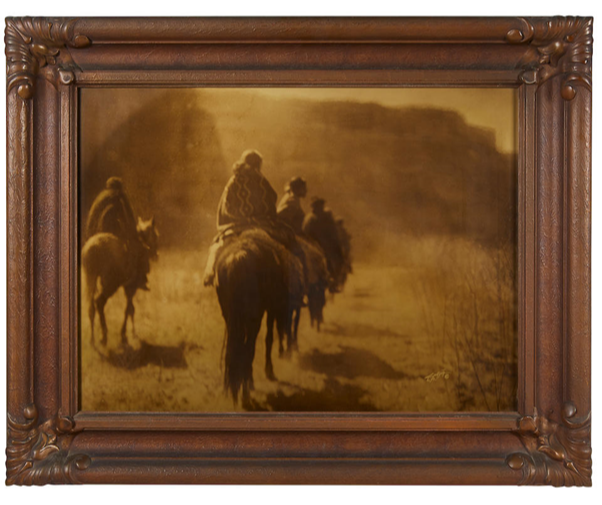Edward S. Curtis’ Survey of Native Americans Will Hit the Auction Block With Bonhams & Santa Fe Art Auction

American photographer Edward S. Curtis is best known for his extensive documentation of the American West. One of the most influential photographers of the 20th century, his admirers included President Theodore Roosevelt and J. P. Morgan.
In a career spanning over 50 years, Curtis spent decades documenting Native American tribes in his 20-volume life’s work, The North American Indian. This June, Bonhams and Santa Fe Art Auction will each present a selection of items from Curtis’ massive ethnographic survey.
Making its auction debut, the Bonhams collection comes from Southern California collector and Curtis’ family friend Dr. Billy Utley. The Curtis Studio sale begins on June 30th, 2021 at 4:00 PM EDT. The Santa Fe Art Auction collection comes from Christopher Cardozo, a renowned art collector, dealer, and publisher. That event begins on June 26th, 2021 at 12:00 PM EDT. Learn more about Edward S. Curtis’ seminal work before the sales begin.
The Inception of The North American Indian
Born in 1868 on a rural farm near Whitewater, Wisconsin, Edward S. Curtis began his career as an apprentice photographer in St. Paul.
Curtis’ first Native American portrait was of Princess Angeline, who he met in Seattle in 1895. She made her living digging clams. Curtis paid her a dollar for each pose. In his letter to Harriet Leitch in 1951, he mentioned the incident: “This seemed to please her greatly, and with hands and jargon she indicated that she preferred to spend her time having pictures made than in digging clams.”
Soon, he became deeply interested in documenting indigenous North American cultures. In 1906, Curtis garnered financial support from J. P. Morgan, who agreed to pay him USD 75,000 over five years in return for 25 sets of volumes and 500 original prints.

The 20-volume set of The North American Indian containing 1,511 hand-gravure printed illustrations will lead the upcoming Santa Fe Art Auction event (lot #160, estimate: $150,000 – $250,000).
The First & Subsequent Volumes
Curtis published the first volume of The North American Indian in 1907 with a foreword by President Theodore Roosevelt, for whom Curtis worked several years earlier. The Vanishing Race—Navaho image is the first plate of the first volume of The North American Indian. In its review, The New York Herald called the series “the most gigantic undertaking in the making of books since the King James edition of the Bible.”

An oversized orotone print of The Vanishing Race is among the highlights of the Bonhams event (lot #3, estimate: $20,000 – $30,000). The picture shows Native American horsemen riding into a dark and indistinct distance.
An Abrupt End
The positive reviews for his first volume led Curtis to produce subsequent parts of The North American Indian to great acclaim. In 1913, when Curtis had just finished the 11th volume, J. P. Morgan died. Although Morgan Jr. continued to fund the project, he offered smaller sums. Curtis eventually abandoned his fieldwork due to a lack of funding.

Featured in the Bonhams event are 22 cyanotypes from volume XI (lot #132, estimate: $25,000 – $35,000). The cyanotypes contain portraits and photographs of Clayoquot, Hesquiat, and other Nootka tribes.
In 1919, Curtis tried to revive the project one more time. However, he failed to do so after many tribes relocated. By this time, the American market had lost interest in Curtis’ work. He could barely produce any new photographs, and in 1930, Curtis published the last volume of The North American Indian.
Legacy & Criticism
From 1896 to 1930, Curtis took 40,000 photographic images of over 80 Native American tribes west of the Mississippi. The 20-volume set has over 2,234 plates, including 1,511 plates bound in volumes and 723 plates in the portfolios. Despite the vastness and importance of his work, Curtis went bankrupt, suffered a physical and mental breakdown, and died in 1952. His work remained forgotten until it was re-discovered in the 1970s.
Recent years have seen increased critiques of Curtis’ work. According to some, the photography offers a staged image of Native life and neglects the harsh reality in which Native Americans lived. Many scholars criticize Curtis for depicting an idealized version of Native Americans when they were actively being oppressed. Additionally, Curtis often excluded women, posed subjects in stereotypical and inaccurate scenes, and intruded upon sacred ceremonies. Collectors of his work will have to reconcile these criticisms with the immense historical and cultural impact of Curtis’ photographs.
Santa Fe Art Auction’s The Christopher Cardozo Edward S. Curtis Collection sale begins on June 26th, 2021, at 12:00 PM EDT. Bonhams’ The Curtis Studio sale begins on June 30th, 2021, at 4:00 PM EDT. Register to bid and view each of the lots on Bonhams and Santa Fe Art Auction.
Interested in other historical items? Auction Daily recently sat down with Katie Horstman, Cowan’s Senior Specialist of American History, to discuss American historical ephemera and photography.











